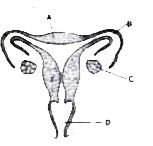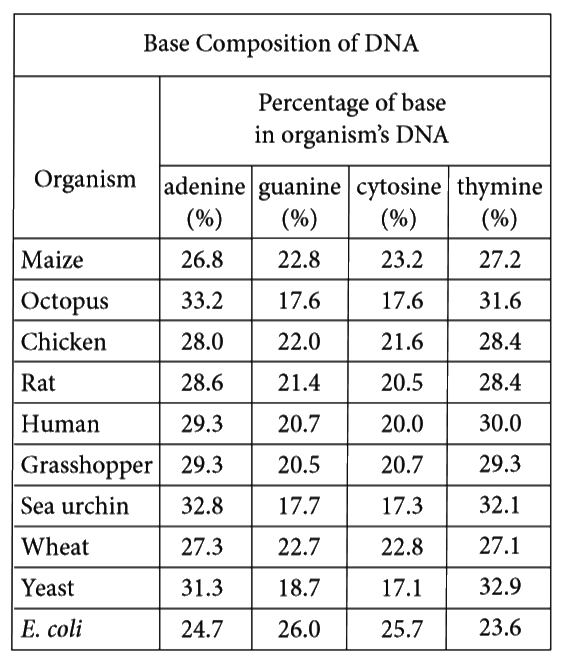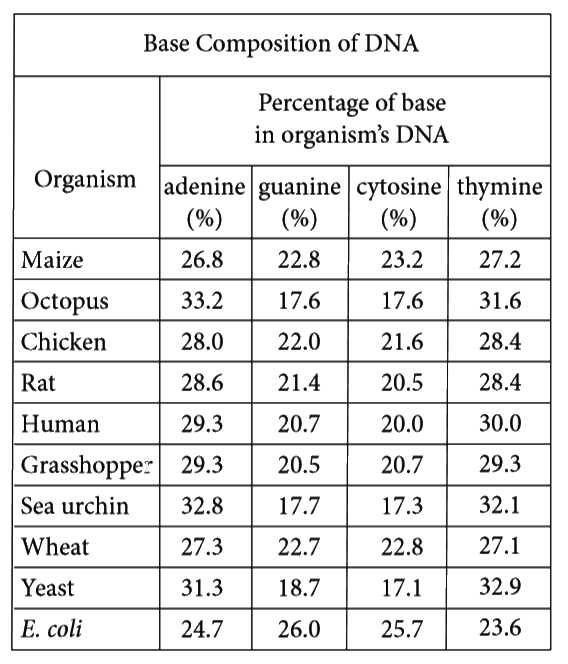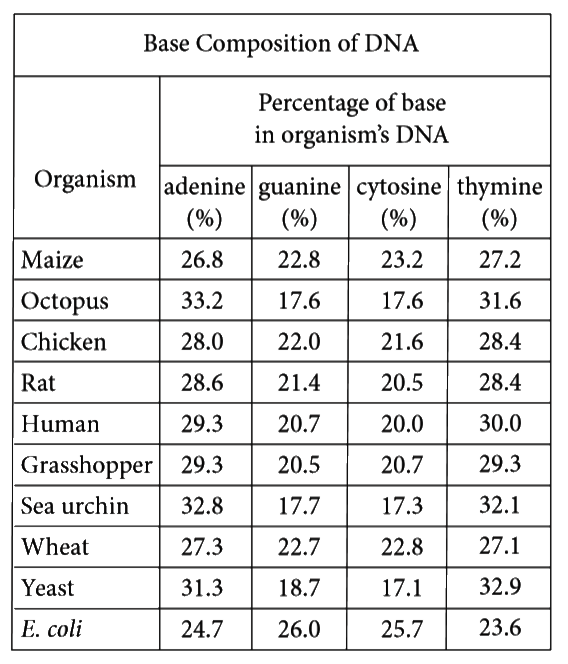The female reproductive system ovidust a pair of ovaries and ____________ along with a single __________ and a vagina. Besides these , a pair of ___________ glands is also present. From puberty, an ovum is released every month alternately from each ____________ until _____________ that occurs around 40-50 years of in females. The free end of the oviduct is ____________ shaped.
The female reproductive system ovidust a pair of ovaries and oviduct along with a single uterus and a vagina. Besides these , a pair of Bartholin'sglands is also present. From puberty, an ovum is released every month alternately from each ovary until menopause that occurs around 40-50 years of in females. The free end of the oviduct is funnel shaped.
Topper's Solved these Questions
- LIFE PROCESSES IN LIVING ORGANISM PART-2BOOK - TARGET PUBLICATIONCHAPTER - LIFE PROCESSES IN LIVING ORGANISM PART-2EXERCISE - NAME THE FOLLOWING
30 Videos
- LIFE PROCESSES IN LIVING ORGANISM PART-2BOOK - TARGET PUBLICATIONCHAPTER - LIFE PROCESSES IN LIVING ORGANISM PART-2EXERCISE - TRUE OR FALSE
44 Videos
- LIFE PROCESSES IN LIVING ORGANISM PART-2BOOK - TARGET PUBLICATIONCHAPTER - LIFE PROCESSES IN LIVING ORGANISM PART-2EXERCISE - APPLY YOUR KNOWLEDGE
52 Videos
- INTRODUCTION TO MICROBIOLOGY BOOK - TARGET PUBLICATIONCHAPTER - INTRODUCTION TO MICROBIOLOGY EXERCISE - APPLY YOUR KNOWLEDGE
26 Videos
- LIFE PROCESSES IN LIVING ORGANISMS PART - 1 BOOK - TARGET PUBLICATIONCHAPTER - LIFE PROCESSES IN LIVING ORGANISMS PART - 1 EXERCISE - CAN YOU RECALL?
38 Videos
Similar Questions
The figure given below represents the female reproductive system of a mammal. Parts indicated by the guidelines A to D are as follows:

(A) Uterus
(B) Fallopian tube (oviduct)
(C) Ovary
(D) Vagina
(a) Give appropriate terms for each of the following:
(i) The onset of reproductive phase in a young female.
(ii) Rupture of follicle and release of ovum from the ovary
(iii) Monthly discharge of blood and disintegrated tissues in human female.
(iv) Process of fusion of ovum and sperm.
(v) Fixing of developing zygote on the uterine wall.
(vi) The permanent stoppage of menstruation at about the age of 45 years in a female.
(b) State the functions of the (0) Placenta (ii) Amniotic fluid. [ICSE 2004, 2015]
(c) Using the symbol "X' indicates the region in the diagram where fertilisation occurs.[ICSE 2004)
View Solution(a) In human male as well as female reproductive systems there is an organ which apart from producing germ-cells, also plays the role of an endocrine gland. Name the organ for each of the reproductive systems. Draw a diagram of female reproductive system and label on it-cervix and vagina.
(b) Name the site of fertilization and also the place where fertilized egg gets implanted in female reproductive system.
(c) State the advantage of development of embryo in mother's womb.
View Solution
Knowledge Check
Rhythmic reproductive cycle in female primates (Monkeys, apes, humans etc.) is called menstrual cycle. The first menstrual cycle (Menarche) that begins at puberty. It is repeated after an average interval of 28/29 days. Release of one ovum takes place in the middle of each menstrual cycle. The menstrual cycle ceases around post 50 years of age in humans and that stage is called Menopause. Proper understanding of the Menstrual cycle can be used to apply periodic abstinence which is a method of natural birth control. A couple can stay away from performing coitus/ sexual intercourse between the 10th and 17th of the menstrual cycle. These are the days when ovulation takes place, resulting in higher chances of fertilisation. This can help with a natural course of family planning.
The beginning of menstruation in human females is known as:AMenarcheBMenopauseCMenstrual kinkDLuteal degenerationRhythmic reproductive cycle in female primates (Monkeys, apes, humans etc.) is called menstrual cycle. The first menstrual cycle (Menarche) that begins at puberty. It is repeated after an average interval of 28/29 days. Release of one ovum takes place in the middle of each menstrual cycle. The menstrual cycle ceases around post 50 years of age in humans and that stage is called Menopause. Proper understanding of the Menstrual cycle can be used to apply periodic abstinence which is a method of natural birth control. A couple can stay away from performing coitus/ sexual intercourse between the 10th and 17th of the menstrual cycle. These are the days when ovulation takes place, resulting in higher chances of fertilisation. This can help with a natural course of family planning.
Menstrual phase can last for:A24-48 hoursB28 or 29 daysC10-14 daysD3-5 daysRhythmic reproductive cycle in female primates (Monkeys, apes, humans etc.) is called menstrual cycle. The first menstrual cycle (Menarche) that begins at puberty. It is repeated after an average interval of 28/29 days. Release of one ovum takes place in the middle of each menstrual cycle. The menstrual cycle ceases around post 50 years of age in humans and that stage is called Menopause. Proper understanding of the Menstrual cycle can be used to apply periodic abstinence which is a method of natural birth control. A couple can stay away from performing coitus/ sexual intercourse between the 10th and 17th of the menstrual cycle. These are the days when ovulation takes place, resulting in higher chances of fertilisation. This can help with a natural course of family planning.
During Luteal phase, corpus luteum secretes large amount of .................... for endometrium maintenance.AProgesteroneBTestosteroneCLuteinising hormoneDEstrogen
Rhythmic reproductive cycle in female primates (Monkeys, apes, humans etc.) is called menstrual cycle. The first menstrual cycle (Menarche) that begins at puberty. It is repeated after an average interval of 28/29 days. Release of one ovum takes place in the middle of each menstrual cycle. The menstrual cycle ceases around post 50 years of age in humans and that stage is called Menopause. Proper understanding of the Menstrual cycle can be used to apply periodic abstinence which is a method of natural birth control. A couple can stay away from performing coitus/ sexual intercourse between the 10th and 17th of the menstrual cycle. These are the days when ovulation takes place, resulting in higher chances of fertilisation. This can help with a natural course of family planning.
Primary follicle changes into Graafian follicle in ............... phase.
View SolutionRhythmic reproductive cycle in female primates (Monkeys, apes, humans etc.) is called menstrual cycle. The first menstrual cycle (Menarche) that begins at puberty. It is repeated after an average interval of 28/29 days. Release of one ovum takes place in the middle of each menstrual cycle. The menstrual cycle ceases around post 50 years of age in humans and that stage is called Menopause. Proper understanding of the Menstrual cycle can be used to apply periodic abstinence which is a method of natural birth control. A couple can stay away from performing coitus/ sexual intercourse between the 10th and 17th of the menstrual cycle. These are the days when ovulation takes place, resulting in higher chances of fertilisation. This can help with a natural course of family planning.
In absence of fertilisation, corpus luteum .............
View SolutionThe chemical formula of deoxyribonucleic acid
(DNA) is now well established. The molecule is a
very long chain, the backbone of which consists of a
regular alternation of sugar and phosphate groups.
5 To each sugar is attached a nitrogenous base, which
can be of four different types. Two of the possible
bases—adenine and guanine—are purines, and the
other two—thymine and cytosine—are pyrimidines.
So far as is known, the sequence of bases along the
10 chain is irregular. The monomer unit, consisting of
phosphate, sugar and base, is known as a nucleotide.
The first feature of our structure which is of
biological interest is that it consists not of one chain,
but of two. These two chains are both coiled around
15 a common fiber axis. It has often been assumed that
since there was only one chain in the chemical
formula there would only be one in the structural
unit. However, the density, taken with the X-ray
evidence, suggests very strongly that there are two.
20. The other biologically important feature is the
manner in which the two chains are held together.
This is done by hydrogen bonds between the bases.
The bases are joined together in pairs, a single base
from one chain being hydrogen-bonded to a single
25 base from the other. The important point is that only
certain pairs of bases will fit into the structure.
One member of a pair must be a purine and the other
a pyrimidine in order to bridge between the two
chains. If a pair consisted of two purines, for
30 example, there would not be room for it.
We believe that the bases will be present almost
entirely in their most probable forms. If this is true,
the conditions for forming hydrogen bonds are more
restrictive, and the only pairs of bases possible are:
35 adenine with thymine, and guanine with cytosine.
Adenine, for example, can occur on either chain, but
when it does, its partner on the other chain must
always be thymine.
The phosphate-sugar backbone of our model is
40 completely regular, but any sequence of the pairs of
bases can fit into the structure. It follows that in a
long molecule many different permutations are
possible, and it therefore seems likely that the precise
sequence of bases is the code which carries the
45 genetical information. If the actual order of the bases
on one of the pair of chains were given, one could
write down the exact order of the bases on the other
one, because of the specific pairing. Thus one chain
is, as it were, the complement of the other, and it is
50 this feature which suggests how the deoxyribonucleic
acid molecule might duplicate itself.
The table shows, for various organisms, the percentage of
each of the four types of nitrogenous bases in that
organism’s DNA.

Adapted from Manju Bansal, “DNA Structure: Revisiting the
Watson-Crick Double Helix.” ©2003 by Current Science Association,
Bangalore
31. Based on the table, is the percentage of adenine in each organism’s DNA the same or does it vary, and which statement made by the authors is most consistent with that data?
View SolutionThe chemical formula of deoxyribonucleic acid
(DNA) is now well established. The molecule is a
very long chain, the backbone of which consists of a
regular alternation of sugar and phosphate groups.
5 To each sugar is attached a nitrogenous base, which
can be of four different types. Two of the possible
bases—adenine and guanine—are purines, and the
other two—thymine and cytosine—are pyrimidines.
So far as is known, the sequence of bases along the
10 chain is irregular. The monomer unit, consisting of
phosphate, sugar and base, is known as a nucleotide.
The first feature of our structure which is of
biological interest is that it consists not of one chain,
but of two. These two chains are both coiled around
15 a common fiber axis. It has often been assumed that
since there was only one chain in the chemical
formula there would only be one in the structural
unit. However, the density, taken with the X-ray
evidence, suggests very strongly that there are two.
20. The other biologically important feature is the
manner in which the two chains are held together.
This is done by hydrogen bonds between the bases.
The bases are joined together in pairs, a single base
from one chain being hydrogen-bonded to a single
25 base from the other. The important point is that only
certain pairs of bases will fit into the structure.
One member of a pair must be a purine and the other
a pyrimidine in order to bridge between the two
chains. If a pair consisted of two purines, for
30 example, there would not be room for it.
We believe that the bases will be present almost
entirely in their most probable forms. If this is true,
the conditions for forming hydrogen bonds are more
restrictive, and the only pairs of bases possible are:
35 adenine with thymine, and guanine with cytosine.
Adenine, for example, can occur on either chain, but
when it does, its partner on the other chain must
always be thymine.
The phosphate-sugar backbone of our model is
40 completely regular, but any sequence of the pairs of
bases can fit into the structure. It follows that in a
long molecule many different permutations are
possible, and it therefore seems likely that the precise
sequence of bases is the code which carries the
45 genetical information. If the actual order of the bases
on one of the pair of chains were given, one could
write down the exact order of the bases on the other
one, because of the specific pairing. Thus one chain
is, as it were, the complement of the other, and it is
50 this feature which suggests how the deoxyribonucleic
acid molecule might duplicate itself.
The table shows, for various organisms, the percentage of
each of the four types of nitrogenous bases in that
organism’s DNA.

Adapted from Manju Bansal, “DNA Structure: Revisiting the
Watson-Crick Double Helix.” ©2003 by Current Science Association,
Bangalore
23. A student claims that nitrogenous bases pair randomly with one another. Which of the following statements in the passage contradicts the student’s claim?
View SolutionThe chemical formula of deoxyribonucleic acid
(DNA) is now well established. The molecule is a
very long chain, the backbone of which consists of a
regular alternation of sugar and phosphate groups.
5 To each sugar is attached a nitrogenous base, which
can be of four different types. Two of the possible
bases—adenine and guanine—are purines, and the
other two—thymine and cytosine—are pyrimidines.
So far as is known, the sequence of bases along the
10 chain is irregular. The monomer unit, consisting of
phosphate, sugar and base, is known as a nucleotide.
The first feature of our structure which is of
biological interest is that it consists not of one chain,
but of two. These two chains are both coiled around
15 a common fiber axis. It has often been assumed that
since there was only one chain in the chemical
formula there would only be one in the structural
unit. However, the density, taken with the X-ray
evidence, suggests very strongly that there are two.
20. The other biologically important feature is the
manner in which the two chains are held together.
This is done by hydrogen bonds between the bases.
The bases are joined together in pairs, a single base
from one chain being hydrogen-bonded to a single
25 base from the other. The important point is that only
certain pairs of bases will fit into the structure.
One member of a pair must be a purine and the other
a pyrimidine in order to bridge between the two
chains. If a pair consisted of two purines, for
30 example, there would not be room for it.
We believe that the bases will be present almost
entirely in their most probable forms. If this is true,
the conditions for forming hydrogen bonds are more
restrictive, and the only pairs of bases possible are:
35 adenine with thymine, and guanine with cytosine.
Adenine, for example, can occur on either chain, but
when it does, its partner on the other chain must
always be thymine.
The phosphate-sugar backbone of our model is
40 completely regular, but any sequence of the pairs of
bases can fit into the structure. It follows that in a
long molecule many different permutations are
possible, and it therefore seems likely that the precise
sequence of bases is the code which carries the
45 genetical information. If the actual order of the bases
on one of the pair of chains were given, one could
write down the exact order of the bases on the other
one, because of the specific pairing. Thus one chain
is, as it were, the complement of the other, and it is
50 this feature which suggests how the deoxyribonucleic
acid molecule might duplicate itself.
The table shows, for various organisms, the percentage of
each of the four types of nitrogenous bases in that
organism’s DNA.

Adapted from Manju Bansal, “DNA Structure: Revisiting the
Watson-Crick Double Helix.” ©2003 by Current Science Association,
Bangalore
26. Based on the passage, the authors’ statement “If a pair consisted of two purines, for example, there would not be room for it” (lines 29-30) implies that a pair
View Solution
